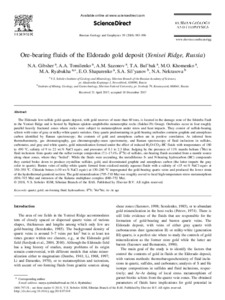Показать сокращенную информацию
Ore-bearing fluids of the Eldorado gold deposit (Yenisei Ridge, Russia)
| Автор | Некрасова, Наталья Александровна | |
| Автор | Gibsher, N. A. | |
| Автор | Tomilenko, A. A. | |
| Автор | Sazonov, A. M. | |
| Автор | Bul'bak T.A | |
| Автор | Khomenko, M. O. | |
| Автор | Ryabukha, M. A. | |
| Автор | Shaparenko, E. O. | |
| Автор | Sil'Yanov, S. A. | |
| Дата внесения | 2019-07-01T07:21:31Z | |
| Дата, когда ресурс стал доступен | 2019-07-01T07:21:31Z | |
| Дата публикации | 2018-08 | |
| Библиографическое описание | Некрасова, Наталья Александровна. Ore-bearing fluids of the Eldorado gold deposit (Yenisei Ridge, Russia) [Текст] / Наталья Александровна Некрасова, N. A. Gibsher, A. A. Tomilenko, A. M. Sazonov, Bul'bak T.A, M. O. Khomenko, M. A. Ryabukha, E. O. Shaparenko, S. A. Sil'Yanov // Russian Geology and Geophysics. — 2018. — С. 983-996 | |
| ISSN | 10687971 | |
| URI (для ссылок/цитирований) | https://www.sciencedirect.com/science/article/pii/S1068797118301573 | |
| URI (для ссылок/цитирований) | https://elib.sfu-kras.ru/handle/2311/110459 | |
| Описание | Текст статьи не публикуется в открытом доступе в соответствии с политикой журнала. | |
| Аннотация | The Eldorado low-sulfide gold-quartz deposit, with gold reserves of more than 60 tons, is located in the damage zone of the Ishimba Fault in the Yenisei Ridge and is hosted by Riphean epidote-amphibolite metamorphic rocks (Sukhoi Pit Group). Orebodies occur in four roughly parallel heavily fractured zones where rocks were subject to metamorphism under stress and heat impacts. They consist of sulfide-bearing schists with veins of gray or milky-white quartz varieties. Gray quartz predominating in gold-bearing orebodies contains graphite and amorphous carbon identified by Raman spectroscopy; the contents of gold and amorphous carbon are in positive correlation. As inferred from thermobarometry, gas chromatography, gas chromatography-mass spectrometry, and Raman spectroscopy of fluid inclusions in sulfides, carbonates, and gray and white quartz, gold mineralization formed under the effect of reduced H2O-CO2-HC fluids with temperatures of 180 to 490 °C, salinity of 9 to 22 wt.% NaCl equiv, and pressures of 0.1 to 2.3 kbar. Judging by the presence of 11% mantle helium (3He) in fluid inclusions from quartz and the sulfur isotope composition (7.1-17.4‰ δ34S) of sulfides, ore-bearing fluids ascended from a mantle source along shear zones, where they “boiled”. While the fluids were ascending, the metalliferous S- and N-bearing hydrocarbon (HC) compounds they carried broke down to produce crystalline sulfides, gold, and disseminated graphite and amorphous carbon (the latter imparts the gray color to quartz). Barren veins of milky-white quartz formed from oxidized mainly aqueous fluids with a salinity of < 15 wt.% NaCl equiv at 150-350 °C. Chloride brines (> 30 wt.% NaCl equiv) at 150-260 °C impregnated the gold-bearing quartz veins and produced the lower strata of the hydrothermal-granitoid section. The gold mineralization (795-710 Ma) was roughly coeval to local high-temperature stress metamorphism (836-745 Ma) and intrusion of the Kalama multiphase complex (880-752 Ma). | |
| Название | Ore-bearing fluids of the Eldorado gold deposit (Yenisei Ridge, Russia) | |
| Тип | Journal Article | |
| Тип | Published Journal Article | |
| Страницы | 983-996 | |
| ГРНТИ | 38.33 | |
| Дата обновления | 2019-07-01T07:21:31Z | |
| DOI | 10.1016/j.rgg.2018.07.018 | |
| Институт | Институт горного дела, геологии и геотехнологий | |
| Подразделение | Кафедра геологии, минералогии и петрографии | |
| Журнал | Russian Geology and Geophysics | |
| Квартиль журнала в Scopus | Q1 | |
| Квартиль журнала в Web of Science | Q3 |

